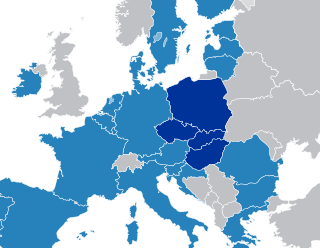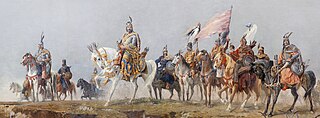
Central Europe is the region comprising the central part of Europe. It is said to occupy continuous territory that are otherwise conventionally Western Europe, Southern Europe, and Eastern Europe. The concept of Central Europe is based on a common historical, social and cultural identity. Central Europe is going through a phase of "strategic awakening", with initiatives such as the CEI, Centrope and the Visegrád Four. While the region's economy shows high disparities with regard to income, all Central European countries are listed by the Human Development Index as very highly developed.

Hungary is a country in Central Europe. Spanning 93,030 square kilometres (35,920 sq mi) in the Carpathian Basin, it borders Slovakia to the north, Ukraine to the northeast, Austria to the northwest, Romania to the east, Serbia to the south, Croatia to the southwest, and Slovenia to the west. With about 10 million inhabitants, Hungary is a medium-sized member state of the European Union. The official language is Hungarian, which is the most widely spoken Uralic language in the world. Hungary's capital and its largest city and metropolis is Budapest. Other major urban areas include Debrecen, Szeged, Miskolc, Pécs and Győr.

Hungary wields considerable influence in Central and Eastern Europe and is a middle power in international affairs. The foreign policy of Hungary is based on four basic commitments: to Atlantic co-operation, to European integration, to international development and to international law. The Hungarian economy is fairly open and relies strongly on international trade.

The Visegrád Group, Visegrád Four, or V4 is a cultural and political alliance of four Central European states – the Czech Republic, Hungary, Poland and Slovakia, that are members of the European Union (EU) and NATO – for the purposes of advancing military, cultural, economic and energy cooperation with one another along with furthering their integration in the EU.

Budapest is the capital and the most populous city of Hungary, and the tenth-largest city in the European Union by population within city limits. The city had an estimated population of 1,752,704 in 2016 distributed over a land area of about 525 square kilometres. Budapest is both a city and county, and forms the centre of the Budapest metropolitan area, which has an area of 7,626 square kilometres and a population of 3,303,786, comprising 33 percent of the population of Hungary.

Fidesz – Hungarian Civic Alliance is a national-conservative, right-wing populist political party in Hungary.

The Hungaroring is a motorsport race track in Mogyoród, Hungary where the Formula One Hungarian Grand Prix is held. In 1986, it became the location of the first Formula One Grand Prix behind the Iron Curtain. Bernie Ecclestone wanted a race in the USSR, but a Hungarian friend recommended Budapest. They wanted a street circuit similar to the Circuit de Monaco to be built in the Népliget – Budapest's largest park – but the government decided to build a new circuit just outside the city near a major highway. Construction works started on 1 October 1985. It was built in eight months, less time than any other Formula One circuit. The first race was held on 24 March 1986, in memory of János Drapál, the first Hungarian who won motorcycle Grand Prix races. According to a survey put together by the national tourism office of Hungary, Mogyoród ranks third among Hungarian destinations visited by tourists, behind the Danube Bend area and Lake Balaton, but ahead of Budapest. The circuit has FIA Grade 1 license.
The Hungary national football team represents Hungary in international football and is controlled by the Hungarian Football Federation.

Wizz Air, legally incorporated as Wizz Air Hungary Ltd. and stylised as W!zz Air, is a Hungarian low-cost airline with its head office in Budapest. The airline serves many cities across Europe, as well as some destinations in North Africa and the Middle East. It has the largest fleet of any Hungarian airline, although it is not a flag carrier, and currently serves 44 countries. Its Jersey based parent company, Wizz Air Holdings plc, is listed on the London Stock Exchange and is a constituent of the FTSE 250 Index. As of 2018, the airline has its largest hub at Budapest Airport with over 60 destinations. In 2018 the airline transported 33.8 million passengers.

Viktor Mihály Orbán is a Hungarian politician serving as Prime Minister of Hungary since 2010. He also served as Prime Minister from 1998 to 2002. He is the present leader of the national conservative Fidesz party, a post he has held since 2003 and, previously, from 1993 to 2000.

Ferencvárosi Torna Club, known as Ferencváros, is a professional football club based in Ferencváros, Budapest, Hungary, that competes in the Nemzeti Bajnokság I, the top flight of Hungarian football. Ferencváros was founded in 1899 by Ferenc Springer and a group of local residents of Budapest's ninth district, Ferencváros. Ferencváros is best known internationally for winning the 1964–65 edition of the Inter-Cities Fairs Cup after defeating Juventus 1–0 in Turin and for reaching the final in the same competition in 1968, when they lost to Leeds United and the final in the 1974–75 season of the European Cup Winners' Cup, lost to Dinamo Kiev.
The Nemzeti Bajnokság is the Hungarian professional league for association football clubs. The league is currently known as the OTP Bank Liga for sponsorship reasons, and it has been the highest level of the professional league since its inception in 1901. UEFA currently ranks the league 36th in Europe.

The Hungarian Greek Catholic Church or Hungarian Byzantine Catholic Church is a Metropolitan sui iuris ("autonomous") Eastern Catholic particular Church in full communion with the Catholic Church. It is headquartered in Debrecen. Its liturgical rite is the Byzantine Rite in Hungarian.

The Hungarian Revolution of 1848 was one of the many European Revolutions of 1848 and closely linked to other revolutions of 1848 in the Habsburg areas. The revolution in the Kingdom of Hungary grew into a war for independence from the Austrian Empire, ruled by the Habsburg dynasty.

Hungarians, also known as Magyars, are a nation and ethnic group native to Hungary and historical Hungarian lands who share a common culture, history and language. Hungarians belong to the Uralic-speaking peoples. There are an estimated 14.2–14.5 million ethnic Hungarians and their descendants worldwide, of whom 9.6 million live in today's Hungary. About 2.2 million Hungarians live in areas that were part of the Kingdom of Hungary before the Treaty of Trianon and are now parts of Hungary's seven neighbouring countries, especially Slovakia, Ukraine, Romania, Serbia, Croatia, Slovenia and Austria. Significant groups of people with Hungarian ancestry live in various other parts of the world, most of them in the United States, Canada, Germany, France, the United Kingdom, Brazil, Australia, and Argentina. Hungarians can be classified into several subgroups according to local linguistic and cultural characteristics; subgroups with distinct identities include the Székelys, the Csángós, the Palóc, the Matyó and the Jász people, the last being considered an Iranic ethnic group being closely related to the Ossetians.
Anti-Hungarian sentiment is dislike, distrust, racism, or xenophobia directed against the Hungarians. It can involve hatred, grievance, distrust, intimidation, fear, and hostility towards the Hungarian people, language and culture.
The 2014–15 Nemzeti Bajnokság I, also known as NB I, was the 113th season of top-tier football in Hungary. The league is officially named OTP Bank Liga for sponsorship reasons. The season began 26 July 2014 and concluded on 1 June 2015. Debrecen are the defending champions having won their seventh Hungarian championship last season.

Hungary competed at the 2016 Summer Olympics in Rio de Janeiro, Brazil, from 5 to 21 August 2016. Hungarian athletes have appeared in every edition of the Summer Olympic Games, except for two occasions. Hungary was not invited to the 1920 Summer Olympics in Antwerp, because of its role in the first World War, and it was also part of the Soviet boycott, when Los Angeles hosted the 1984 Summer Olympics.

The European migrant crisis or refugee crisis is a term given to a period beginning in 2013 when rising numbers of people arrived in the European Union (EU) from across the Mediterranean Sea or overland through Southeast Europe. It is part of a pattern of increased immigration to Europe from other continents which began in the mid-20th century and which has encountered resistance in many European countries.
The 2015–16 Nemzeti Bajnokság I, also known as NB I, is the 117th season of top-tier football in Hungary. The league is officially named OTP Bank Liga for sponsorship reasons. The season began 17 July 2015 and will conclude on 8 May 2016. Videoton are the defending champions having won their second Hungarian championship last season.




















